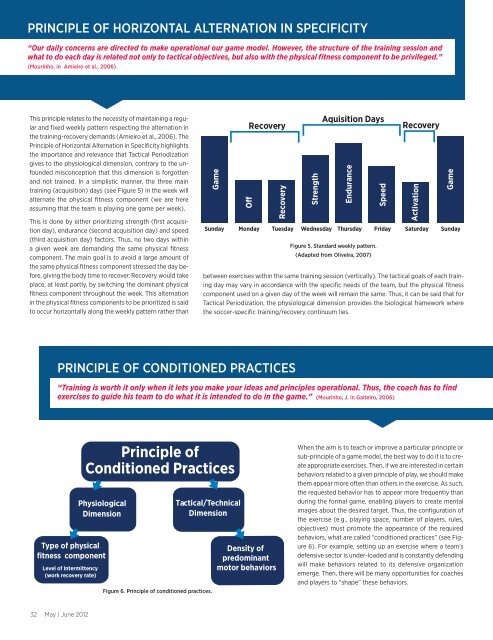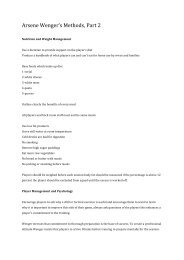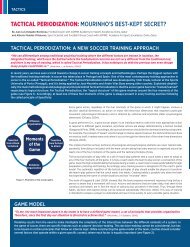Tactical Peroidization.pdf
- No tags were found...
Create successful ePaper yourself
Turn your PDF publications into a flip-book with our unique Google optimized e-Paper software.
Principle of horizontal alternation in specificity<br />
“Our daily concerns are directed to make operational our game model. However, the structure of the training session and<br />
what to do each day is related not only to tactical objectives, but also with the physical fitness component to be privileged.”<br />
(Mourinho, in Amieiro et al., 2006)<br />
This principle relates to the necessity of maintaining a regular<br />
and fixed weekly pattern respecting the alternation in<br />
the training-recovery demands (Amieiro et al., 2006). The<br />
Principle of Horizontal Alternation in Specificity highlights<br />
the importance and relevance that <strong>Tactical</strong> Periodization<br />
gives to the physiological dimension, contrary to the unfounded<br />
misconception that this dimension is forgotten<br />
and not trained. In a simplistic manner, the three main<br />
training (acquisition) days (see Figure 5) in the week will<br />
alternate the physical fitness component (we are here<br />
assuming that the team is playing one game per week).<br />
This is done by either prioritizing strength (first acquisition<br />
day), endurance (second acquisition day) and speed<br />
(third acquisition day) factors. Thus, no two days within<br />
a given week are demanding the same physical fitness<br />
component. The main goal is to avoid a large amount of<br />
the same physical fitness component stressed the day before,<br />
giving the body time to recover. Recovery would take<br />
place, at least partly, by switching the dominant physical<br />
fitness component throughout the week. This alternation<br />
in the physical fitness components to be prioritized is said<br />
to occur horizontally along the weekly pattern rather than<br />
Game<br />
Recovery<br />
Recovery<br />
Strength<br />
Aquisition Days<br />
Figure 5. Standard weekly pattern.<br />
(Adapted from Oliveira, 2007)<br />
between exercises within the same training session (vertically). The tactical goals of each training<br />
day may vary in accordance with the specific needs of the team, but the physical fitness<br />
component used on a given day of the week will remain the same. Thus, it can be said that for<br />
<strong>Tactical</strong> Periodization, the physiological dimension provides the biological framework where<br />
the soccer-specific training/recovery continuum lies.<br />
Endurance<br />
Speed<br />
Recovery<br />
Activation<br />
Game<br />
Principle of conditioned practices<br />
“Training is worth it only when it lets you make your ideas and principles operational. Thus, the coach has to find<br />
exercises to guide his team to do what it is intended to do in the game.” (Mourinho, J. in Gaiteiro, 2006)<br />
Type of physical<br />
Level of Intermittency<br />
(work recovery rate)<br />
Principle of<br />
Conditioned Practices<br />
Physiological<br />
Dimension<br />
<strong>Tactical</strong>/Technical<br />
Dimension<br />
Figure 6. Principle of conditioned practices.<br />
Density of<br />
predominant<br />
motor behaviors<br />
When the aim is to teach or improve a particular principle or<br />
sub-principle of a game model, the best way to do it is to create<br />
appropriate exercises. Then, if we are interested in certain<br />
behaviors related to a given principle of play, we should make<br />
them appear more often than others in the exercise. As such,<br />
the requested behavior has to appear more frequently than<br />
during the formal game, enabling players to create mental<br />
images about the desired target. Thus, the configuration of<br />
the exercise (e.g., playing space, number of players, rules,<br />
objectives) must promote the appearance of the required<br />
behaviors, what are called “conditioned practices” (see Figure<br />
6). For example, setting up an exercise where a team’s<br />
defensive sector is under-loaded and is constantly defending<br />
will make behaviors related to its defensive organization<br />
emerge. Then, there will be many opportunities for coaches<br />
and players to “shape” these behaviors.<br />
32 May | June 2012







